Thermal Energy Transfer
Heat Pump Failure: Is Thermal Energy Transfer Guilty?

Fed up with your heat pump breaking down at the worst possible moments? We have some surprising information for you. The issue could very well be related to the process of thermal energy transfer!
Yes, you heard that right. In this article, we’ll dive deep into the world of heat pump failures and explore the role that thermal energy transfer plays in their performance.
Get ready for some mind-blowing insights and practical tips to keep your heat pump running smoothly. Let’s get started!
Key Takeaways
- Common causes of heat pump failure include refrigerant leaks, faulty thermostat, motor failures, compressor problems, and frozen coils.
- Thermal energy transfer plays a crucial role in heat pump performance, with conduction, convection, and radiation being the main methods of heat transfer.
- Proper insulation and choice of refrigerant are important factors in maximizing heat pump efficiency and minimizing heat loss.
- Signs of thermal energy transfer issues in heat pumps include insufficient heating or cooling, reduced airflow, ice buildup, and strange noises. Regular maintenance and optimization are crucial for efficient operation.
Common Causes of Heat Pump Failure
We often experience various malfunctions in heat pumps due to the frequent occurrence of mechanical issues. When it comes to heat pump repair, understanding the common heat pump issues is crucial.

One common problem is refrigerant leaks, which can cause a drop in cooling or heating capacity. Another issue is a faulty thermostat, which can result in temperature inconsistencies. Additionally, motor failures can occur due to worn-out bearings or electrical problems. Compressor problems, such as overheating or failure to start, are also common. Lastly, frozen coils can lead to reduced airflow and a decrease in heat transfer efficiency.
By addressing these common heat pump issues promptly, we can ensure optimal performance and prevent further damage.
Now, let’s delve into the next section and explore the role of thermal energy transfer in heat pump failure.
Understanding Thermal Energy Transfer
Let’s explore how thermal energy transfer plays a crucial role in heat pump failure. Understanding heat transfer mechanisms is essential in identifying the potential causes of heat pump malfunctions. Thermal energy transfer occurs in everyday life and can be classified into three main mechanisms: conduction, convection, and radiation.
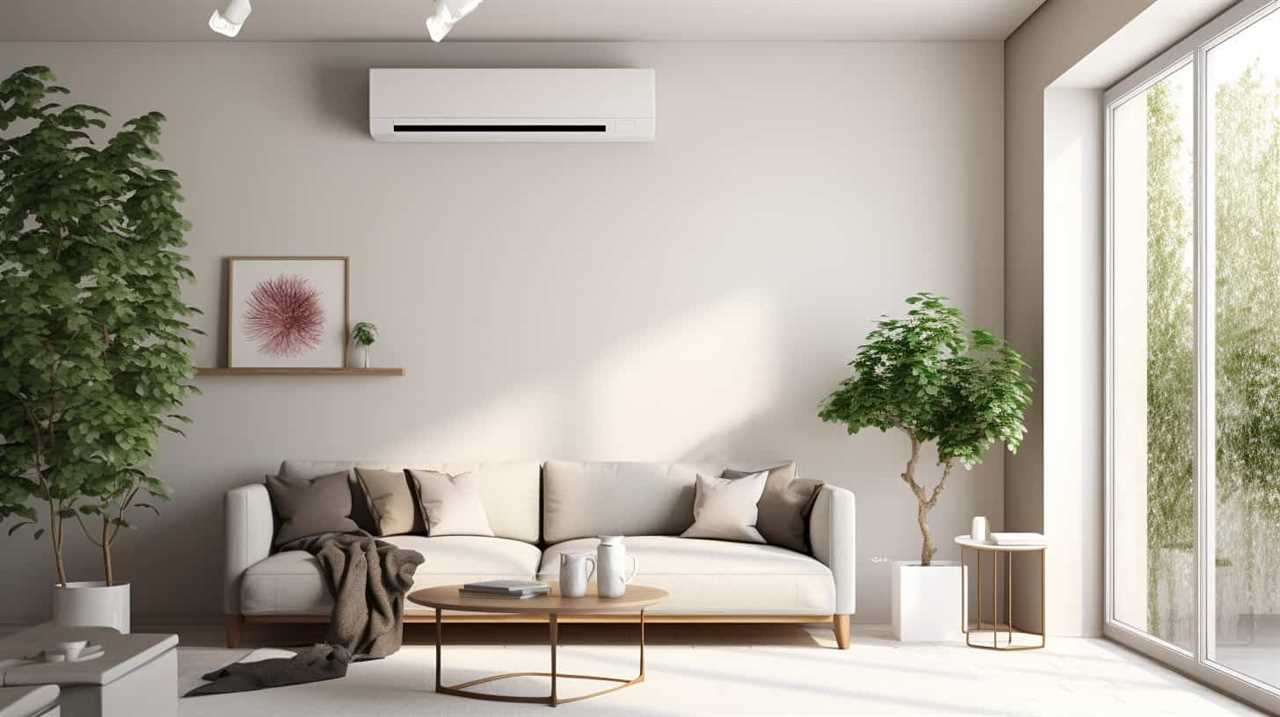
| Heat Transfer Mechanism | Description |
|---|---|
| Conduction | The transfer of heat through direct contact between two objects or substances. It occurs when heat is conducted from a higher temperature region to a lower temperature region. In heat pumps, poor insulation or faulty components can lead to heat loss through conduction. |
| Convection | The transfer of heat through the movement of fluids or gases. In heat pumps, convection is responsible for the circulation of refrigerant and air within the system. Obstructions or improper airflow can hinder efficient heat transfer and result in heat pump failure. |
| Radiation | The transfer of heat through electromagnetic waves. Although radiation plays a minor role in heat pump operation, issues such as inadequate shielding or excessive exposure to external heat sources can impact overall system performance. |
The Role of Thermal Energy Transfer in Heat Pump Performance
To understand the role of thermal energy transfer in heat pump performance, we need to analyze the efficiency of heat transfer mechanisms and their impact on the overall operation of the system.
One crucial factor is the role of insulation. Insulation plays a vital role in minimizing heat loss during the transfer process, ensuring that the heat pump operates at optimal efficiency. By reducing heat loss, insulation helps maintain the desired temperature and reduces the workload on the heat pump, leading to energy savings and improved performance.
Another important aspect is the impact of refrigerant. The choice of refrigerant can significantly affect the heat pump’s performance. Highly efficient refrigerants with excellent heat transfer properties can enhance the system’s overall efficiency, resulting in better heating or cooling output.
Therefore, proper insulation and the right choice of refrigerant are essential factors in maximizing heat pump performance and ensuring customer satisfaction.

Signs of Thermal Energy Transfer Issues in Heat Pumps
What are the signs of thermal energy transfer issues in heat pumps? Troubleshooting heat pumps for thermal energy transfer issues is crucial in maintaining their efficiency and performance. Here are some common signs that indicate potential problems in thermal energy transfer:
| Sign | Description | Possible Cause |
|---|---|---|
| Insufficient heating or cooling | The heat pump fails to reach the desired temperature | Low refrigerant level or a faulty compressor |
| Reduced airflow | Weak airflow from the vents | Clogged air filters or a malfunctioning fan |
| Ice buildup | Ice accumulation on the coils or outside unit | Insufficient airflow or refrigerant leak |
| Strange noises | Unusual sounds such as grinding or squealing | Loose or damaged components |
Identifying these signs can help homeowners troubleshoot thermal energy transfer issues promptly, ensuring optimal heat pump performance. Now let’s explore the impact of thermal energy transfer on heat pump efficiency.
Impact of Thermal Energy Transfer on Heat Pump Efficiency
Regularly maintaining and optimizing thermal energy transfer is crucial for maximizing heat pump efficiency. The impact of thermal energy transfer on heat pump efficiency is significant and can greatly affect both energy consumption and environmental sustainability.
When thermal energy transfer is inefficient, heat pumps require more energy to achieve the desired heating or cooling effect, leading to increased energy consumption. This not only results in higher energy bills for consumers but also puts a strain on the environment by contributing to greenhouse gas emissions.

On the other hand, when thermal energy transfer is optimized, heat pumps operate more efficiently, reducing energy consumption and promoting environmental sustainability. By ensuring proper insulation, minimizing heat loss, and regularly maintaining heat pump components, the impact of thermal energy transfer on heat pump efficiency can be maximized, benefiting both consumers and the environment.
Strategies for Preventing Thermal Energy Transfer Problems
To prevent thermal energy transfer problems in heat pumps, there are several strategies that can be implemented.
First, proper insulation and regular maintenance are crucial in minimizing heat loss or gain through the system. This includes sealing any gaps, cracks, or leaks in the ductwork or insulation.
Secondly, efficient system design plays a significant role in reducing thermal energy transfer. This involves selecting the right size and type of heat pump for the specific application and ensuring proper placement and orientation.

Lastly, proper ventilation and airflow are essential in maintaining optimal heat pump performance. This includes ensuring adequate airflow around the heat pump unit and proper ventilation in the space being heated or cooled.
Insulation and Maintenance
We recommend performing at least two maintenance checks per year to ensure proper insulation and prevent thermal energy transfer problems.
Insulation maintenance is crucial in preventing energy loss and maximizing the efficiency of your heat pump system. One important aspect of insulation maintenance is checking for any signs of wear or damage to the insulation material. Any gaps or cracks should be sealed to prevent air leakage and heat transfer.
Additionally, it’s important to regularly clean and replace air filters to ensure proper airflow and prevent dust and debris from clogging the system.
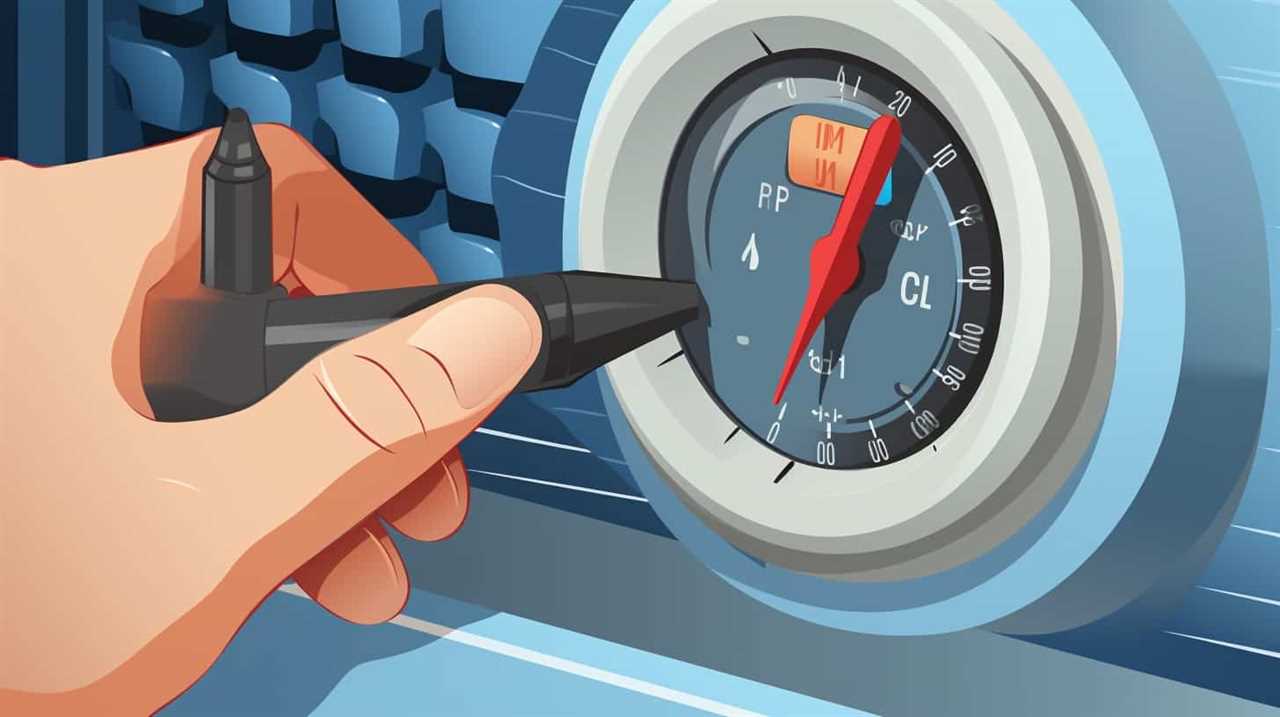
During maintenance checks, it’s also recommended to inspect the ductwork for any leaks or gaps that could lead to energy loss.
Efficient System Design
Our primary focus should be on implementing effective strategies and utilizing proper system design to minimize thermal energy transfer problems and optimize heat pump efficiency. To achieve efficient system optimization, it’s important to consider the following energy saving techniques:
- Proper sizing and selection of heat pump equipment to match the heating and cooling load requirements of the space.
- Insulation of ductwork and piping to prevent heat loss or gain during the transfer process.
- Installation of programmable thermostats to regulate temperature settings and reduce energy consumption during unoccupied periods.
- Use of variable speed motors and fans to adjust the system’s output based on the demand, resulting in reduced energy usage.
- Regular maintenance and cleaning of the heat pump system to ensure efficient operation and prevent the build-up of dirt and debris.
By implementing these strategies, we can enhance the overall performance of the heat pump system and maximize energy savings.
Now, let’s move on to discussing the importance of proper ventilation and airflow in maintaining the efficiency of the system.
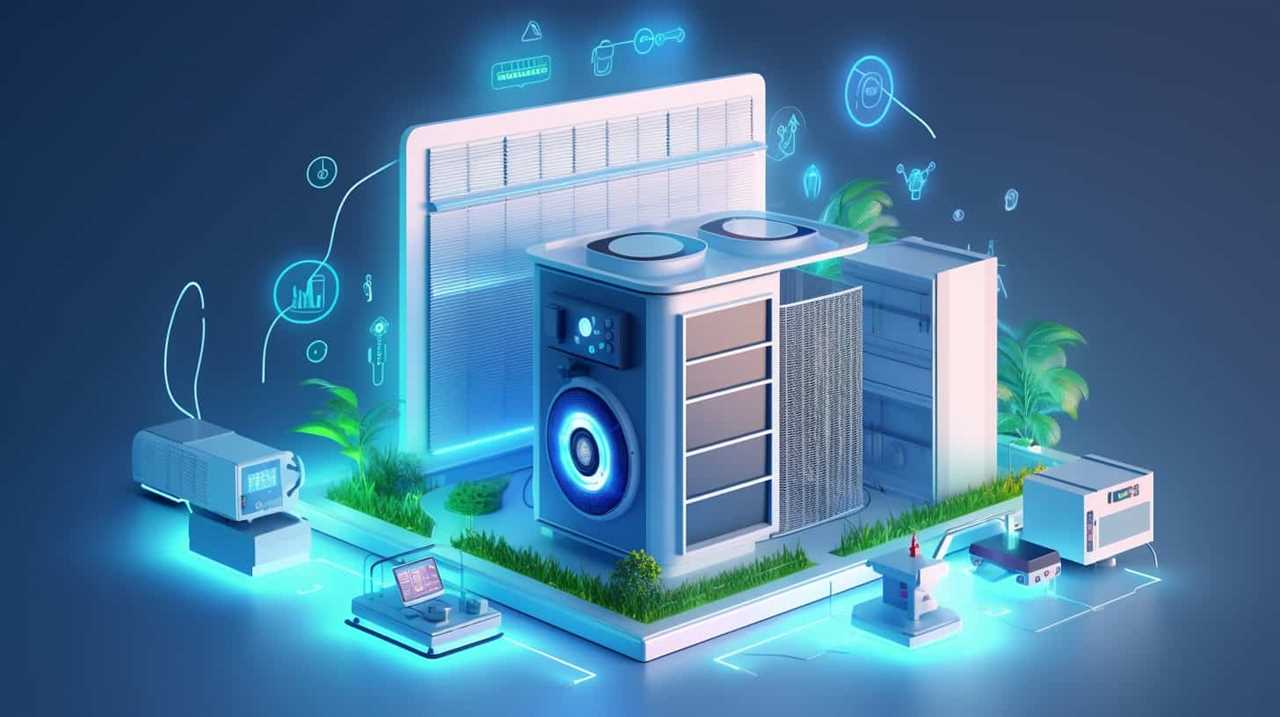
Proper Ventilation and Airflow
Proper ventilation and airflow play a crucial role in preventing thermal energy transfer problems and ensuring the efficient operation of the heat pump system. Adequate ventilation techniques and effective airflow management are essential for maintaining optimal performance and preventing issues such as overheating, inadequate heat transfer, and reduced system efficiency.
One important ventilation technique is ensuring that the heat pump system has sufficient air supply and exhaust vents. This allows for proper air circulation and prevents the buildup of stagnant air, which can hinder heat transfer and impede the system’s ability to maintain desired indoor temperatures.
In addition, airflow management is critical for preventing thermal energy transfer problems. This involves strategically placing vents and registers to ensure even distribution of heated or cooled air throughout the space. Proper airflow management helps eliminate hot or cold spots, improves indoor air quality, and maximizes the heat pump’s efficiency by ensuring that conditioned air reaches all areas of the building.
Troubleshooting Thermal Energy Transfer in Heat Pumps
When troubleshooting thermal energy transfer in heat pumps, we need to consider both the evaporator and condenser coils. The evaporator coil is responsible for absorbing heat from the indoor air, while the condenser coil releases heat to the outdoor air.
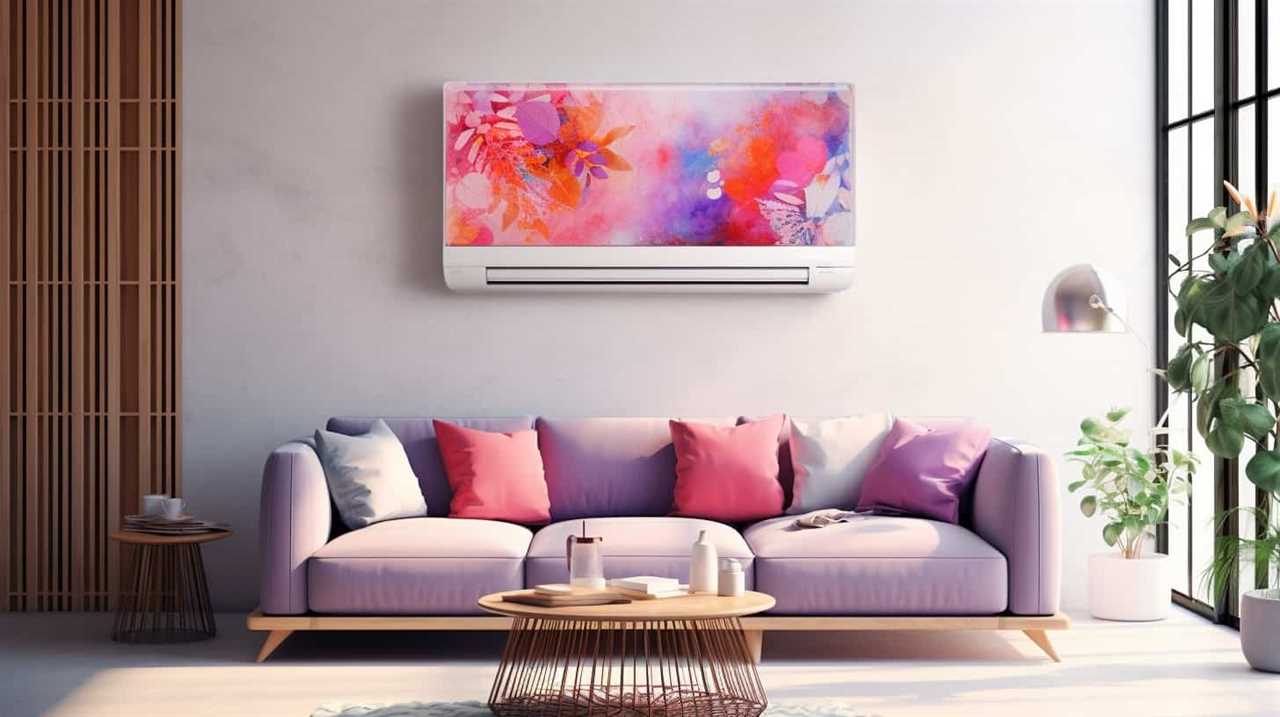
Here are some troubleshooting techniques to consider:
- Check for ice or frost buildup on the evaporator coil, as this can impede heat transfer.
- Inspect the condenser coil for dirt, debris, or blockage, which can reduce its efficiency.
- Verify that the refrigerant levels are sufficient, as low levels can result in poor heat transfer.
- Examine the airflow across both coils to ensure it’s unobstructed and sufficient.
- Test the functionality of the reversing valve, which controls the direction of refrigerant flow for heating or cooling modes.
Frequently Asked Questions
Can Heat Pump Failure Be Caused by Factors Other Than Thermal Energy Transfer Issues?
Yes, heat pump failure can be caused by factors other than thermal energy transfer issues. Common causes include electrical problems, refrigerant leaks, and improper installation. Troubleshooting techniques can help identify and resolve these issues.
How Does Understanding Thermal Energy Transfer Help in Diagnosing Heat Pump Failure?
Understanding thermal energy transfer plays a crucial role in diagnosing heat pump failure. By analyzing the impact of weather conditions and the role of insulation, we can pinpoint the root cause of the issue and provide effective solutions.
Does Thermal Energy Transfer Play a Role in Both Heating and Cooling Modes of a Heat Pump?
In both heating and cooling modes, thermal energy transfer plays a crucial role in the operation of a heat pump. Conduction and convection are key mechanisms involved, and the impact of insulation on thermal energy transfer cannot be underestimated.
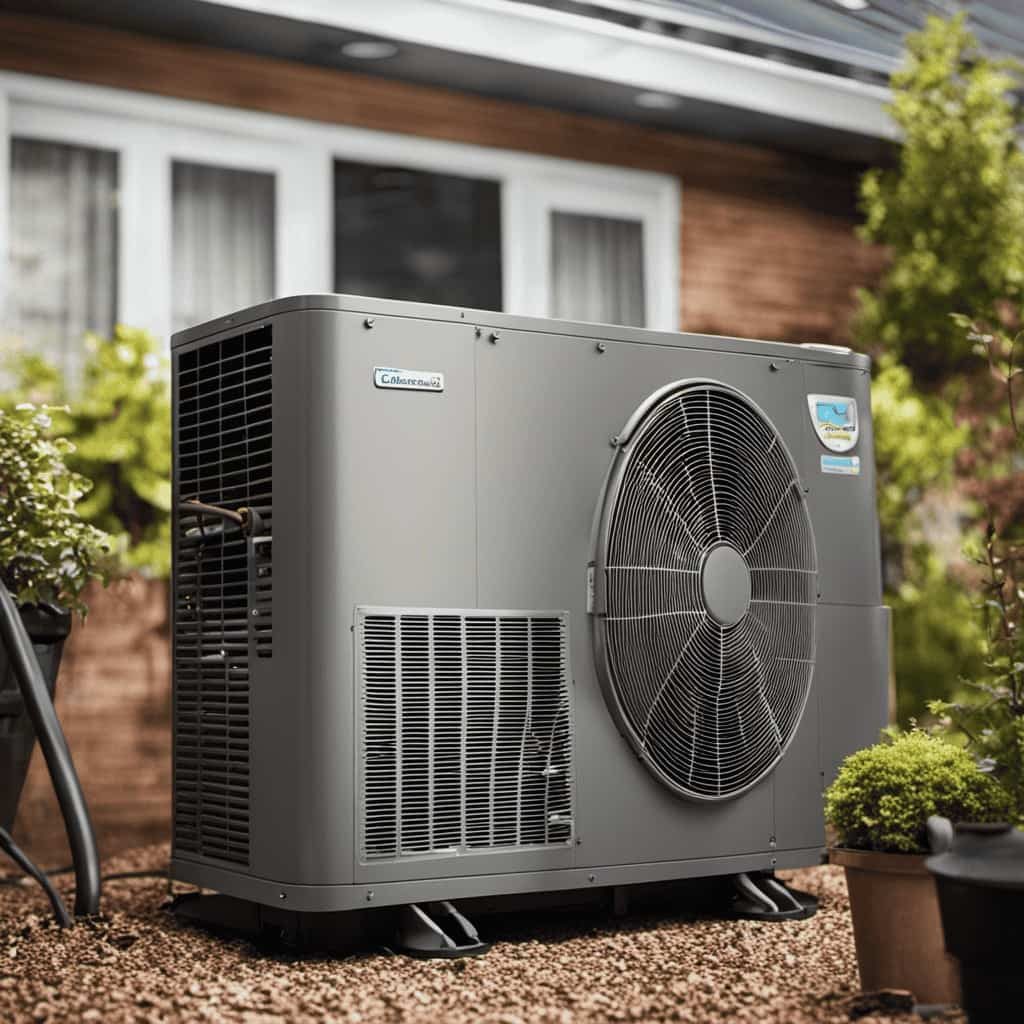
Are There Any Specific Warning Signs to Look Out for That Indicate Thermal Energy Transfer Issues in a Heat Pump?
Common warning signs of thermal energy transfer issues in a heat pump include uneven heating or cooling, reduced airflow, and strange noises. Troubleshooting techniques involve checking for clogged filters, inspecting ductwork, and ensuring proper insulation.
Can Regular Maintenance and Servicing Prevent Thermal Energy Transfer Problems in Heat Pumps?
Regular maintenance and servicing play a crucial role in preventing thermal energy transfer problems in heat pumps. By conducting routine inspections, cleaning components, and ensuring proper refrigerant levels, we can mitigate potential issues and ensure optimal heat pump performance.
Conclusion
In conclusion, understanding the role of thermal energy transfer is crucial in preventing heat pump failure.
By identifying signs of thermal energy transfer issues and implementing strategies to improve efficiency, such as insulation and regular maintenance, the performance of heat pumps can be optimized.
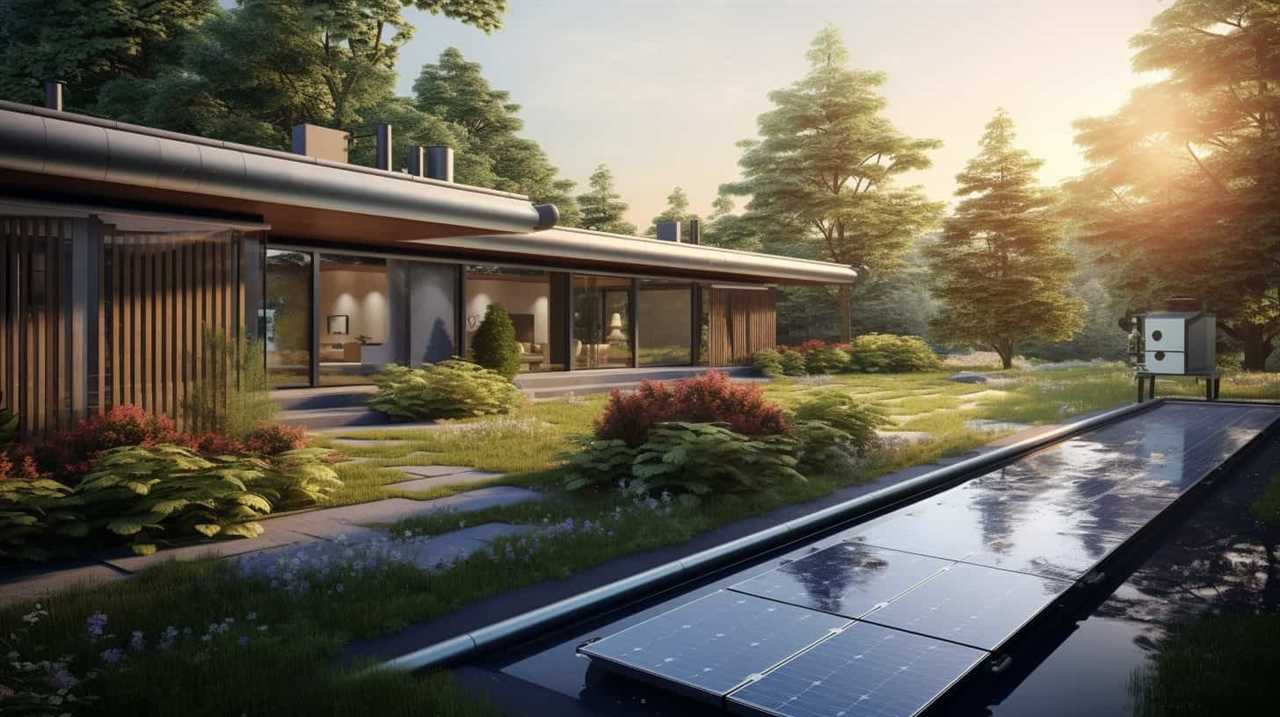
Just as a well-insulated house retains heat effectively, a heat pump that minimizes thermal energy transfer can provide efficient heating and cooling, ensuring a comfortable environment for all.
Thermal Energy Transfer
Boost Heat Pump Efficiency: Renewable Energy’s Unexpected Power

Are you prepared to unleash the complete capabilities of your heat pump? Search no more! In this article, we will delve into the surprising impact of renewable energy on enhancing heat pump effectiveness.
Get ready to revolutionize your heating system as we delve into the role of solar energy, harnessing geothermal power, the game-changing wind energy, sustainable biomass solutions, and the untapped potential of hydropower.
Prepare to master the art of maximizing heat pump performance with the help of renewable energy sources.
Key Takeaways
- Solar panel integration allows for the direct conversion of sunlight into electricity, reducing reliance on traditional power sources.
- Geothermal energy can maximize heat pump performance by providing heat stored beneath the Earth’s surface, leading to higher levels of efficiency.
- Wind power can revolutionize heat pump efficiency by generating electricity to power heat pumps, reducing their carbon footprint.
- Biomass combined with heat pump technology greatly enhances efficiency and sustainability, reducing reliance on fossil fuels and emitting fewer greenhouse gases.
The Role of Solar Energy in Enhancing Heat Pump Efficiency
We can enhance heat pump efficiency by utilizing solar energy. Solar panel integration plays a crucial role in harnessing renewable energy for heat pumps. By connecting solar panels to heat pump systems, we can directly convert sunlight into electricity, reducing reliance on traditional power sources. This integration allows heat pumps to operate more efficiently, as they can draw power from the solar panels during daylight hours.

Additionally, energy storage solutions can further optimize heat pump performance. Storing excess solar energy in batteries or other storage systems ensures a continuous power supply for heat pumps, even when sunlight is limited.
This combination of solar panel integration and energy storage solutions maximizes the utilization of renewable energy, significantly improving heat pump efficiency.
Harnessing Geothermal Power to Maximize Heat Pump Performance
One way to maximize heat pump performance is by harnessing the power of geothermal energy. Geothermal energy is heat that is stored beneath the Earth’s surface in geothermal reservoirs. This heat can be extracted and used to provide heating and cooling for buildings. Geothermal innovations have made it possible to tap into this renewable energy source and optimize the efficiency of heat pumps.
By utilizing geothermal energy, heat pumps can achieve higher levels of efficiency compared to traditional heating and cooling systems. The table below illustrates the advantages of harnessing geothermal power for heat pump performance:
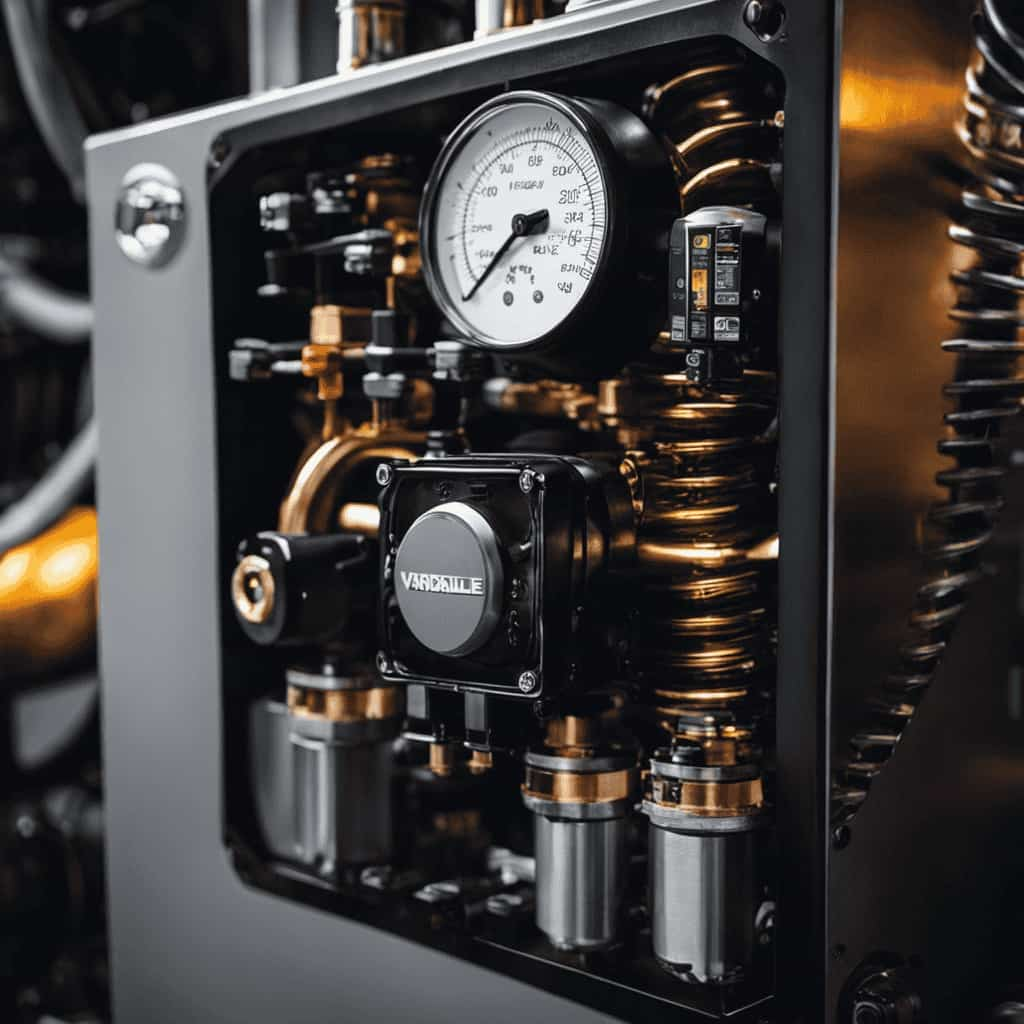
| Advantages of Geothermal Power for Heat Pump Performance |
|---|
| Higher efficiency |
| Reduced energy consumption |
| Lower operating costs |
| Environmentally friendly |
Harnessing geothermal power not only improves the performance of heat pumps but also contributes to a more sustainable and energy-efficient future. By utilizing the abundant geothermal resources available, we can maximize the efficiency of heat pumps and reduce our carbon footprint.
Wind Energy: A Game-Changer for Heat Pump Efficiency
Harnessing wind energy can revolutionize heat pump efficiency.
Wind energy has the potential to be a game changer for heat pump technology, offering significant benefits to renewable energy solutions.
By utilizing wind power to generate electricity, heat pumps can operate more efficiently and reduce their carbon footprint.

Wind turbines can produce large amounts of electricity, which can be used to power heat pumps, allowing them to operate at higher efficiencies.
Additionally, wind energy is a clean and renewable source, making it an environmentally friendly option for heat pump systems.
The integration of wind energy into heat pump technology enhances the overall performance and sustainability of these systems.
Biomass: A Sustainable Solution for Boosting Heat Pump Efficiency
Using biomass as a renewable fuel source and combining it with heat pump technology can greatly enhance efficiency and sustainability. Biomass, which refers to organic materials such as wood, agricultural residues, and dedicated energy crops, offers a promising alternative fuel for heat pumps. By harnessing the energy stored in biomass, heat pumps can provide a reliable and efficient heating solution while reducing reliance on fossil fuels. The innovative combination of biomass and heat pump technology allows for a more sustainable heating system that emits fewer greenhouse gases and decreases overall energy consumption. To illustrate the potential benefits of this approach, consider the table below, which compares the energy efficiency and carbon emissions of biomass-powered heat pumps to conventional heating systems.
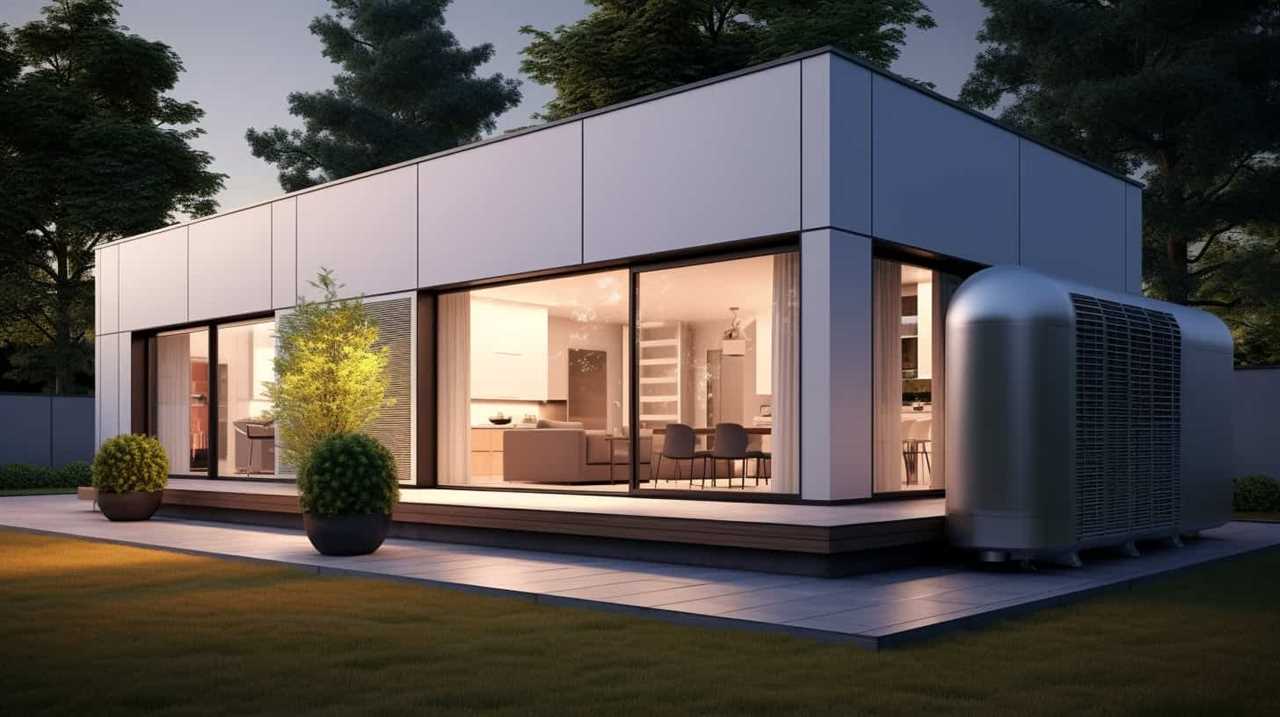
| Heating System | Energy Efficiency (COP) | Carbon Emissions (kgCO2/MWh) |
|---|---|---|
| Biomass Heat Pump | 4.5 | 10 |
| Natural Gas Boiler | 0.9 | 200 |
| Oil Boiler | 0.85 | 250 |
| Electric Resistance | 1 | 500 |
| Air-Source Heat Pump | 3 | 60 |
As shown in the table, biomass heat pumps have a significantly higher energy efficiency and lower carbon emissions compared to other heating systems. This makes them an attractive and sustainable solution for boosting heat pump efficiency.
Hydropower: Unleashing the Potential of Water to Improve Heat Pump Performance
We can maximize heat pump performance by tapping into the immense potential of hydropower, using water as a renewable energy source. Hydropower, also known as hydroelectric power, offers several advantages in improving heat pump efficiency.
- Water Efficiency:
- Hydropower utilizes the natural flow of water, harnessing its kinetic energy to generate electricity.
- This process doesn’t consume water, making it a highly water-efficient energy source.
- Heat pumps can benefit from this water efficiency by leveraging hydropower for their operations, reducing overall water consumption.
- Hydroelectric Power:
- Hydropower plants can generate a significant amount of electricity, providing a reliable and consistent power source for heat pumps.
- The scalability of hydropower allows for large-scale generation, accommodating the increasing demand for heat pump installations.
- By integrating hydropower into heat pump systems, we can enhance their performance and contribute to a more sustainable and efficient energy ecosystem.
Harnessing the power of water through hydropower can significantly improve heat pump performance, ensuring optimal energy utilization and reducing environmental impact.
Frequently Asked Questions
What Are the Key Factors to Consider When Choosing a Heat Pump for Optimal Efficiency?
When choosing a heat pump for optimal efficiency, key factors to consider include heat pump installation and heat pump sizing. These factors play a crucial role in maximizing energy efficiency and ensuring optimal performance.
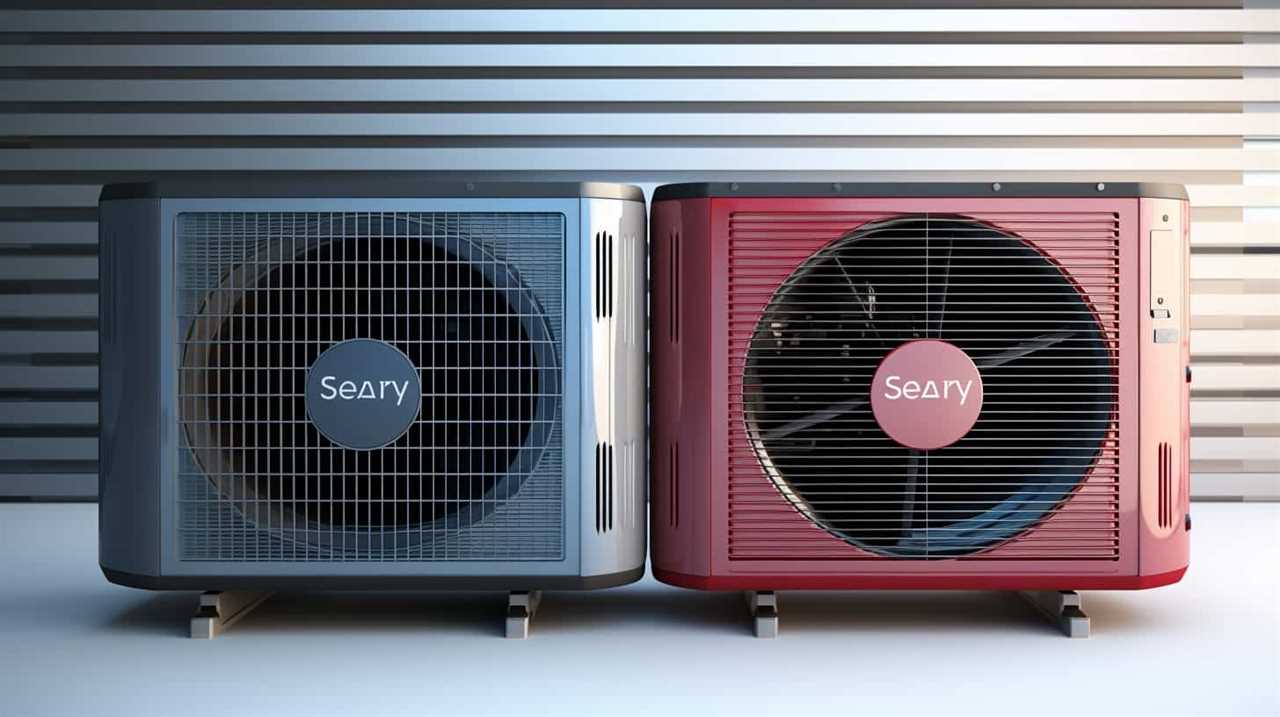
Can Heat Pumps Be Used in All Types of Climates or Are They More Suitable for Specific Regions?
Heat pumps can be used in all types of climates, but their efficiency may vary in extreme conditions. Some limitations include reduced performance in very cold regions and the need for additional heating sources.
Are There Any Government Incentives or Tax Credits Available for Installing Heat Pumps?
There are government incentives and tax credits available for installing heat pumps. These incentives can significantly reduce the upfront cost and make renewable energy more accessible to homeowners and businesses.
How Long Does It Typically Take for a Heat Pump to Pay for Itself in Terms of Energy Savings?
The heat pump payback period depends on various factors, including energy costs, climate, and insulation. It typically takes about 5-10 years for a heat pump to pay for itself in terms of energy savings.
Are There Any Maintenance Requirements or Recommended Practices to Ensure the Long-Term Efficiency of a Heat Pump?
To ensure long-term efficiency, heat pumps require regular maintenance and adherence to recommended practices. These include cleaning or replacing air filters, checking refrigerant levels, and inspecting electrical components. Neglecting these requirements can result in decreased performance and higher energy consumption.
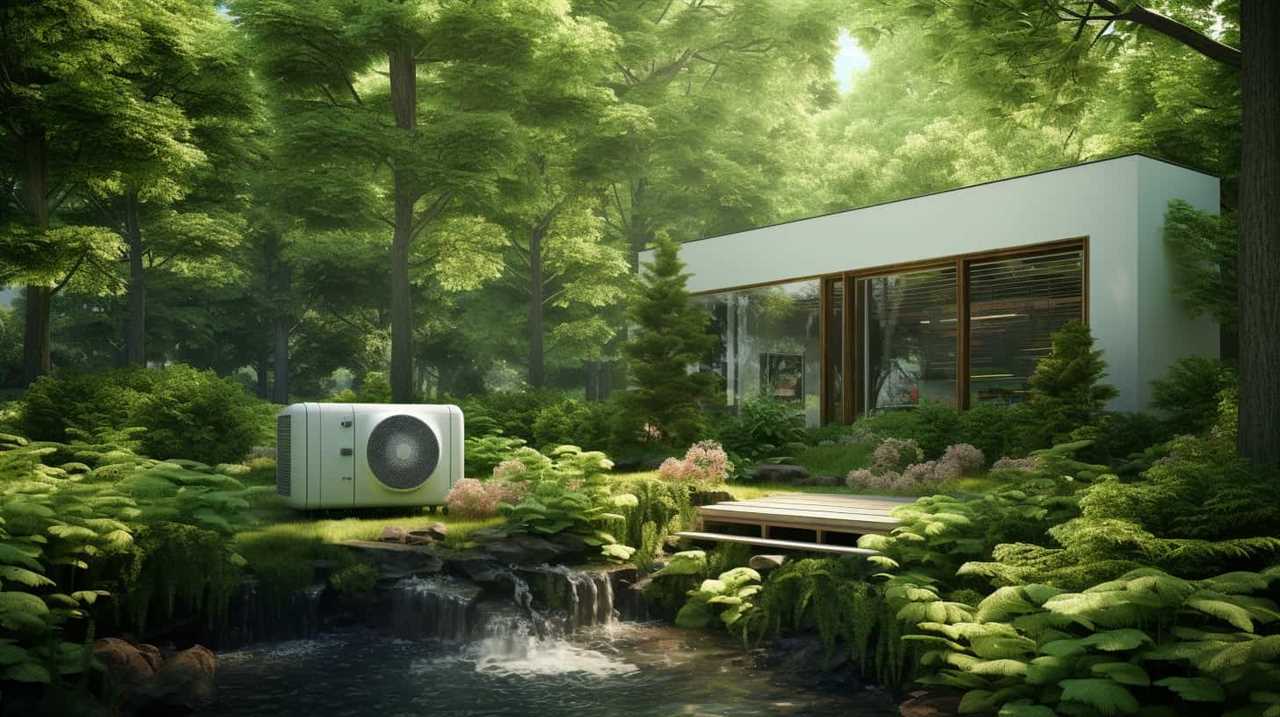
Conclusion
In conclusion, renewable energy sources such as solar, geothermal, wind, biomass, and hydropower play a crucial role in boosting heat pump efficiency.
One interesting statistic to note is that harnessing solar energy can increase heat pump performance by up to 40%, while utilizing geothermal power can improve efficiency by up to 50%.
These renewable energy solutions not only provide sustainable alternatives to traditional heating methods but also contribute to a more energy-efficient and environmentally friendly future.
Thermal Energy Transfer
Decoding Heat Pumps’ Energy Efficiency Ratings: A Guide

Welcome to our guide on understanding the energy efficiency ratings of heat pumps! Have you ever been confused by the numbers and acronyms? We’re here to assist you.
In this article, we’ll break down the importance of energy efficiency ratings, how they’re calculated, and the key metrics to look out for.
We’ll also provide tips on maximizing your heat pump’s performance.
So, let’s dive in and uncover the secrets to choosing the most efficient heat pump for your needs.
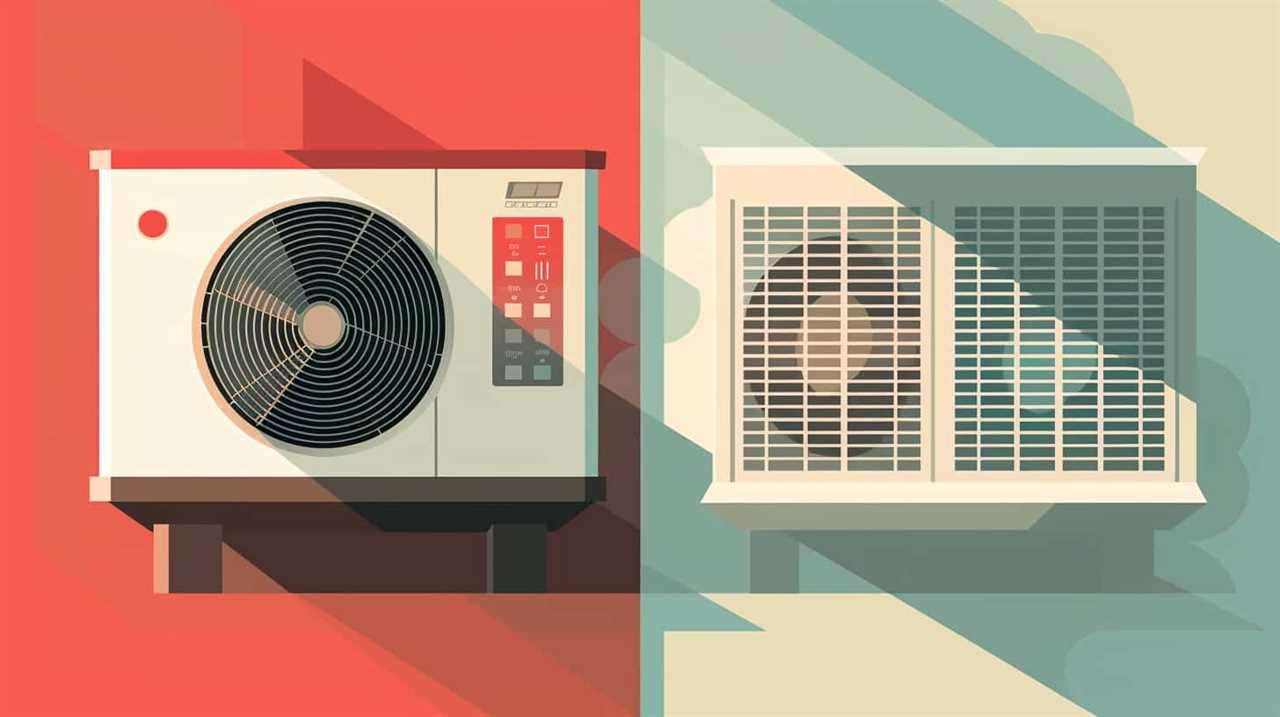
Key Takeaways
- Energy efficiency ratings are important in determining the effectiveness and cost savings of heat pumps.
- Higher efficiency ratings indicate lower energy consumption and can lead to reduced energy bills.
- Heat pumps with higher efficiency ratings often qualify for rebates and incentives.
- Evaluating energy efficiency ratings helps in making informed decisions and maximizing the benefits of heat pumps.
The Importance of Energy Efficiency Ratings in Heat Pumps
We believe that energy efficiency ratings play a crucial role in determining the effectiveness of heat pumps. When evaluating energy savings and long-term cost benefits, it’s important to consider the efficiency rating of a heat pump.
An energy efficiency rating provides a measure of how effectively a heat pump converts electricity into heat. Higher efficiency ratings indicate that the heat pump is more efficient in converting energy, resulting in lower energy consumption and ultimately, cost savings.
By choosing a heat pump with a high energy efficiency rating, homeowners can reduce their energy bills and minimize their environmental impact. Additionally, heat pumps with higher efficiency ratings often qualify for rebates and incentives, further enhancing the long-term cost benefits.
Evaluating energy efficiency ratings is therefore essential in making informed decisions and maximizing the benefits of heat pump technology.

How Energy Efficiency Ratings Are Calculated for Heat Pumps
To determine the energy efficiency rating of a heat pump, manufacturers use standardized testing procedures to measure its performance and calculate the ratio of heat output to electricity input. This calculation process takes into account various factors that affect the efficiency of the heat pump.
Here are some of the factors considered:
- Seasonal Energy Efficiency Ratio (SEER): This measures the cooling efficiency of the heat pump during the cooling season.
- Heating Seasonal Performance Factor (HSPF): This measures the heating efficiency of the heat pump during the heating season.
- Coefficient of Performance (COP): This measures the overall efficiency of the heat pump by considering both the cooling and heating modes.
Understanding SEER and HSPF: Key Energy Efficiency Metrics for Heat Pumps
SEER and HSPF are important energy efficiency metrics that help consumers understand the performance of heat pumps.
When it comes to evaluating the energy efficiency of heat pumps, it’s essential to understand the differences between SEER and HSPF ratings.

SEER, or Seasonal Energy Efficiency Ratio, measures the cooling efficiency of the heat pump. It calculates the amount of cooling output divided by the energy input over a cooling season. The higher the SEER rating, the more energy-efficient the heat pump is in cooling mode.
On the other hand, HSPF, or Heating Seasonal Performance Factor, measures the heating efficiency of the heat pump. It calculates the amount of heating output divided by the energy input over a heating season. A higher HSPF rating indicates better heating efficiency.
Both SEER and HSPF ratings are important when evaluating the energy efficiency of heat pumps. The choice between the two depends on the climate and the specific heating and cooling needs of the consumer. In warmer climates, where cooling demands are higher, SEER rating becomes more important. In colder climates, where heating demands are higher, HSPF rating is more significant.
To make an informed decision, it’s crucial to consider both SEER and HSPF ratings in order to choose a heat pump that meets your specific energy efficiency needs.

Comparing Energy Efficiency Ratings: What to Look for in Heat Pump Models
When comparing energy efficiency ratings, it’s important to regularly and carefully examine the different features of heat pump models. Here are three key aspects to consider when evaluating energy efficiency in heat pump models:
-
Seasonal Energy Efficiency Ratio (SEER): This rating measures the cooling efficiency of the heat pump. Look for a higher SEER rating, as it indicates better energy efficiency and lower operating costs during the cooling season.
-
Heating Seasonal Performance Factor (HSPF): HSPF measures the heating efficiency of the heat pump. A higher HSPF rating means better energy efficiency and lower heating costs during the heating season.
-
Energy Star Certification: Look for heat pump models that have earned the Energy Star certification. These models meet strict energy efficiency guidelines set by the Environmental Protection Agency (EPA) and can help you save on energy usage and costs.
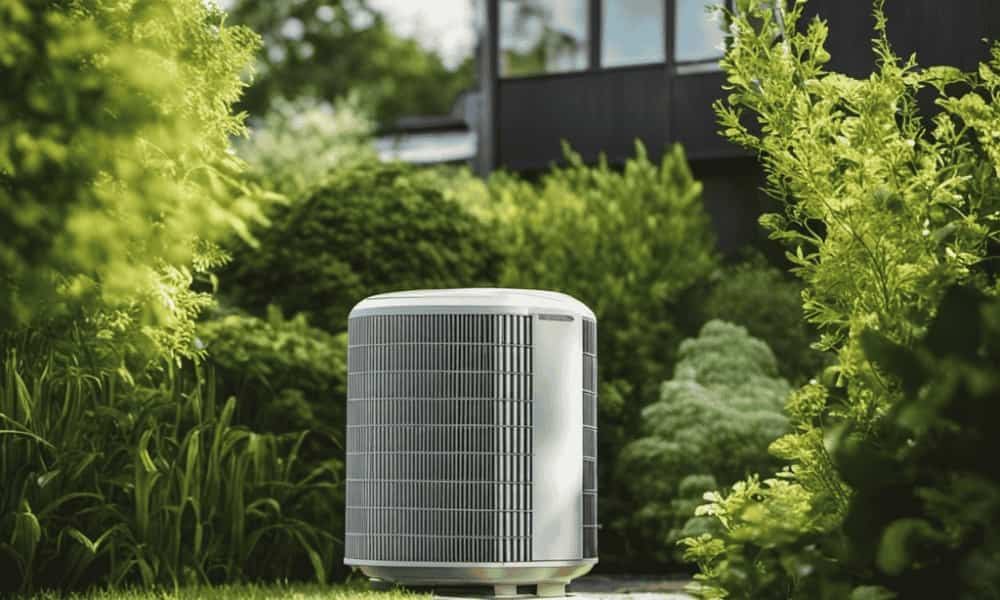
By considering these factors, you can make an informed decision when selecting a heat pump model that prioritizes energy efficiency.
In the next section, we’ll explore tips for maximizing energy efficiency and improving heat pump performance.
Maximizing Energy Efficiency: Tips for Improving Heat Pump Performance
To ensure that we get the most out of our heat pump and maximize its energy efficiency, we should implement these tips for improving its performance. First, regular maintenance is crucial for optimal operation. This includes cleaning or replacing air filters, inspecting and cleaning coils, and checking refrigerant levels. By keeping our heat pump in top condition, we can ensure that it operates efficiently and effectively. Additionally, optimizing the settings on our heat pump can make a significant difference in energy efficiency. Adjusting the thermostat to an appropriate temperature and utilizing programmable settings can help reduce energy consumption. It is also important to consider the size and placement of our heat pump, as these factors can impact its efficiency. By following these tips, we can improve the performance of our heat pump and save on energy costs.
| Tips for Improving Heat Pump Performance |
|---|
| Regular maintenance such as cleaning or replacing air filters, inspecting and cleaning coils, and checking refrigerant levels. |
| Optimizing settings on the heat pump, adjusting the thermostat to an appropriate temperature, and utilizing programmable settings. |
| Considering the size and placement of the heat pump to ensure maximum efficiency. |
Frequently Asked Questions
Are All Heat Pumps Required to Have an Energy Efficiency Rating?
Yes, all heat pumps are required to have an energy efficiency rating. Government regulations and industry standards mandate the inclusion of this rating to provide consumers with information about the product’s energy efficiency performance.

Can the Energy Efficiency Rating of a Heat Pump Change Over Time?
Yes, the energy efficiency rating of a heat pump can change over time due to various factors affecting efficiency. These factors include regular maintenance, age of the equipment, and advancements in technology.
How Can I Determine the Energy Efficiency Rating of My Existing Heat Pump?
To determine the energy efficiency rating of our existing heat pump, we can calculate the efficiency ratio by dividing the output heating or cooling energy by the input electrical energy.
Are There Any Government Incentives or Rebates Available for Purchasing a High-Efficiency Heat Pump?
Yes, there are government incentives and heat pump rebates available for purchasing a high-efficiency heat pump. These incentives and rebates can help reduce the cost and make it more affordable for homeowners to upgrade their heating systems.
Does the Location or Climate Affect the Energy Efficiency Rating of a Heat Pump?
In certain climates, heat pump efficiency ratings can be affected by the location. Additionally, proper installation is crucial for maximizing efficiency. These factors highlight the importance of considering climate and installation when evaluating a heat pump’s energy efficiency.

Conclusion
In conclusion, understanding energy efficiency ratings is crucial when evaluating heat pump options. By decoding SEER and HSPF metrics, consumers can make informed decisions that align with their energy-saving goals.
Comparing ratings and considering tips for maximizing efficiency ensures optimal performance.
Just as a skilled conductor coordinates an orchestra to create a harmonious symphony, homeowners who choose a heat pump with high energy efficiency ratings can enjoy a synchronized blend of comfort and cost savings.
Thermal Energy Transfer
Sustainable Home Design: Heat Pump Systems Efficiency Revealed
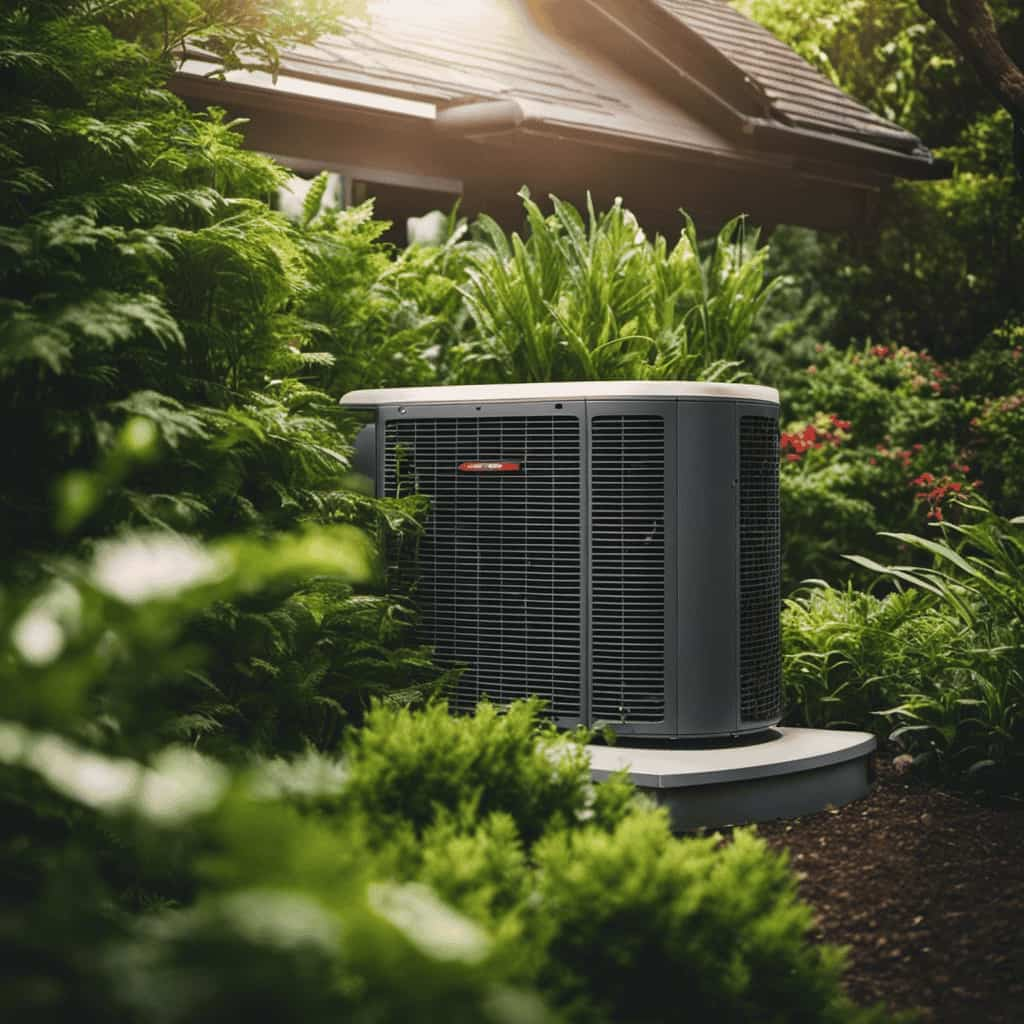
We believed we had a thorough understanding of sustainable home design, but our perspective changed when we learned about the impressive efficiency of heat pump systems.
In this article, we reveal the hidden benefits and secrets of these remarkable systems. From understanding energy efficiency ratings to tips for designing a sustainable home, we’ll guide you through the process of maximizing energy savings.
Prepare to be amazed by the innovations in heat pump technology that can transform your home into an eco-friendly haven.
Let’s dive into the world of heat pump systems and uncover their true potential.

Key Takeaways
- Heat pump systems significantly reduce energy consumption.
- Choosing a system with high SEER and HSPF ratings ensures maximum energy efficiency.
- Proper insulation and optimal system sizing are crucial for efficient heating and cooling.
- Regular maintenance helps maintain optimal system performance and energy efficiency.
The Benefits of Heat Pump Systems in Sustainable Home Design
One of the key benefits of heat pump systems in sustainable home design is that they can significantly reduce energy consumption. This advantage is especially important in today’s world, where energy efficiency is a top priority. By using heat pump systems, homeowners can lower their energy bills and reduce their carbon footprint.
Case studies have shown that these systems can achieve energy savings of up to 50% compared to traditional heating and cooling methods. Additionally, heat pump systems provide both heating and cooling capabilities, eliminating the need for separate systems and saving space.
They also offer precise temperature control and can be easily integrated with renewable energy sources such as solar panels. Overall, heat pump systems are a practical and efficient choice for sustainable home design.
Understanding Energy Efficiency Ratings for Heat Pump Systems
When it comes to understanding energy efficiency ratings for heat pump systems, we need to consider factors such as the Seasonal Energy Efficiency Ratio (SEER) and the Heating Seasonal Performance Factor (HSPF). These ratings are important in evaluating the performance of a heat pump system.

The SEER measures the cooling efficiency of the system during the cooling season, while the HSPF measures the heating efficiency during the heating season. Higher SEER and HSPF ratings indicate greater energy efficiency, which means lower energy consumption and cost savings.
It’s crucial to consider these ratings when choosing a heat pump system for your sustainable home. By opting for a system with high SEER and HSPF ratings, you can ensure maximum energy efficiency and reduce your environmental impact.
In the next section, we’ll discuss tips and considerations for designing a sustainable home with heat pump systems.
Designing a Sustainable Home With Heat Pump Systems: Tips and Considerations
To maximize the energy efficiency of our sustainable home, we should consider various tips and considerations when designing it with heat pump systems. Here are three key factors to keep in mind:

-
Proper insulation: Insulating your home effectively is crucial for reducing heat loss and ensuring that your heat pump system operates efficiently. Insulate walls, floors, and roofs to minimize heat transfer and maintain a comfortable indoor temperature.
-
Optimal system sizing: It’s important to choose the right size heat pump system for your home. Oversized systems can lead to inefficient operation, while undersized systems may struggle to meet your heating and cooling needs. Work with a professional to determine the appropriate size for your specific requirements.
-
Renewable energy integration: Consider integrating renewable energy sources, such as solar panels or wind turbines, with your heat pump system. This allows you to harness clean energy and further reduce your carbon footprint.
Maximizing Energy Savings Through Proper Heat Pump System Sizing
To maximize our energy savings, we need to ensure that our heat pump system is properly sized for our home. A heat pump that is too small will struggle to heat or cool our space efficiently, while a system that is too large will cycle on and off frequently, leading to increased energy consumption and wear and tear on the equipment. Proper heat pump sizing involves considering factors such as the size and layout of our home, insulation levels, and climate conditions. Consulting with a professional during the heat pump installation process is crucial to ensure accurate sizing. Additionally, regular heat pump maintenance, including cleaning filters and checking refrigerant levels, will help maintain optimal system performance and energy efficiency.
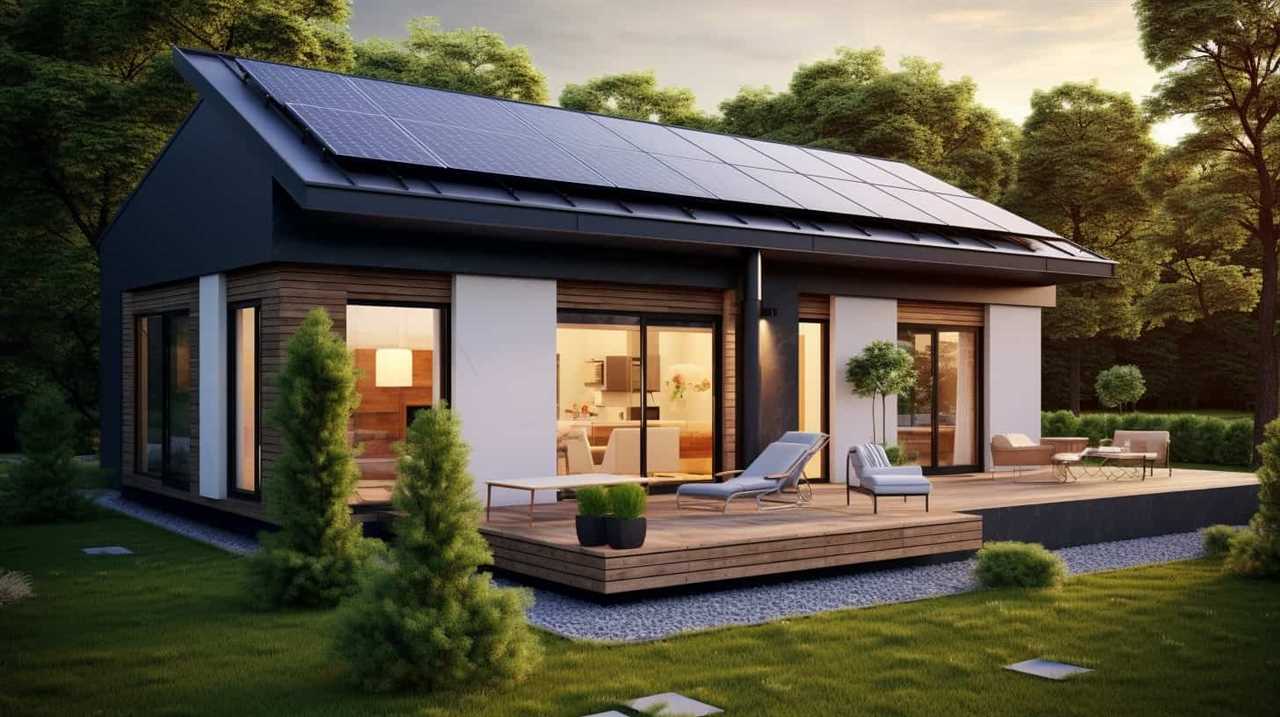
| Factors to Consider for Proper Heat Pump Sizing | |
|---|---|
| Size and layout of our home | Insulation levels |
| Climate conditions | |
| Consultation with a professional during installation | Regular heat pump maintenance |
Innovations in Heat Pump Technology for Sustainable Home Design
We have witnessed remarkable advancements in heat pump technology, revolutionizing sustainable home design. These innovations have brought about significant improvements in the efficiency and performance of heat pump systems, making them an increasingly attractive option for homeowners looking to integrate renewable energy sources into their homes.
Here are three key advancements in heat pump technology:
-
Variable speed compressors: These allow heat pumps to adjust their speed based on the heating or cooling needs of a home, resulting in more precise temperature control and increased energy efficiency.
-
Improved refrigerants: Newer heat pumps use environmentally friendly refrigerants that have a lower impact on the ozone layer and contribute less to global warming.

-
Smart controls and connectivity: Heat pumps now come equipped with smart thermostats and connectivity features, allowing homeowners to remotely control and monitor their systems, optimizing energy usage and reducing costs.
With these advancements, heat pump systems are now a reliable and efficient solution for sustainable home design, offering homeowners the opportunity to reduce their carbon footprint and save on energy bills.
Frequently Asked Questions
Are Heat Pump Systems Suitable for All Types of Homes, or Are There Specific Requirements?
Heat pump systems can be suitable for most homes, but specific requirements, such as adequate insulation and proper sizing, should be met. Consider heat pump system installation costs and the environmental impact when deciding on sustainability.
How Long Do Heat Pump Systems Typically Last Before Needing to Be Replaced?
Heat pump systems typically last around 15-20 years before needing replacement. Factors that affect their lifespan include proper maintenance, usage patterns, and the quality of the system’s components.
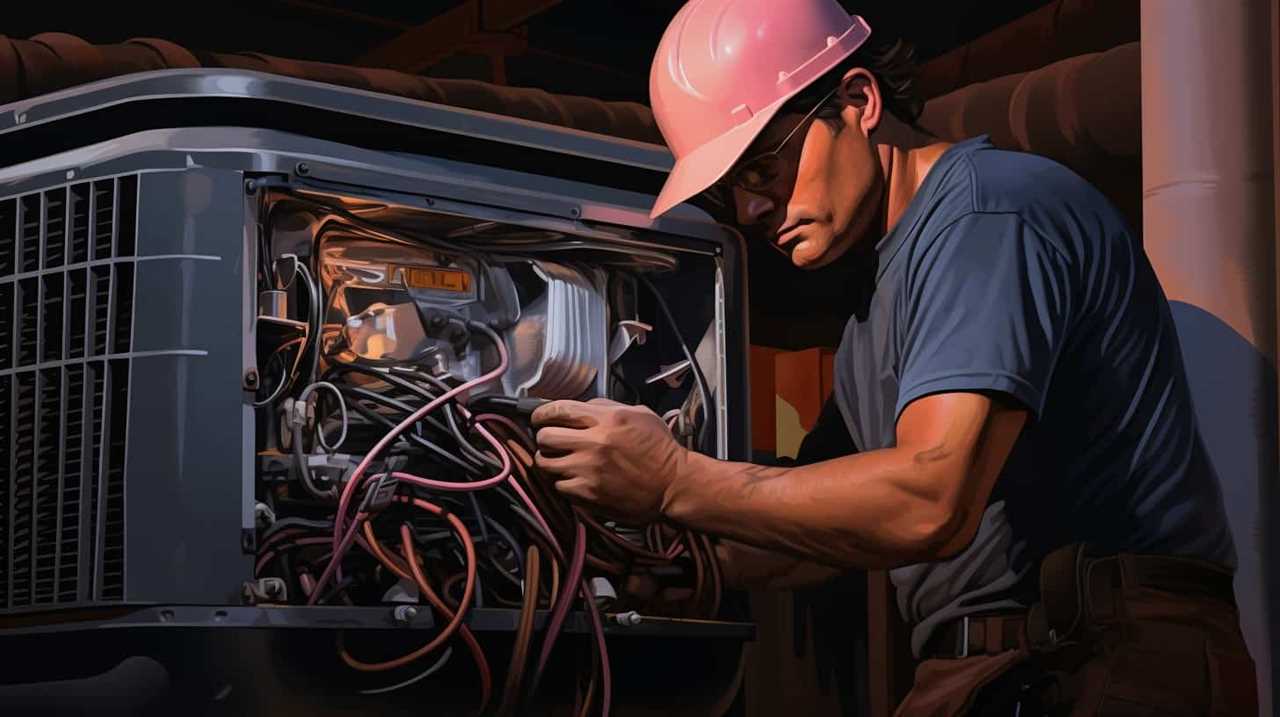
Can Heat Pump Systems Be Used for Both Heating and Cooling Purposes?
Yes, heat pump systems can be used for both heating and cooling purposes. They offer efficient temperature control in our homes. The benefits of using these systems include energy savings and a comfortable living environment.
Are There Any Government Incentives or Rebates Available for Homeowners Who Choose to Install Heat Pump Systems?
Government incentives and rebates are available for homeowners who install heat pump systems. These incentives are designed to encourage energy savings and make sustainable home design more accessible and affordable for everyone.
Are There Any Maintenance Requirements or Costs Associated With Heat Pump Systems?
Maintaining heat pump systems requires regular maintenance to ensure optimal performance. Costs associated with maintenance include filter replacements, annual inspections, and occasional repairs. However, these costs are outweighed by the long-term energy savings and environmental benefits.
Conclusion
In conclusion, heat pump systems are a symbol of efficiency and sustainability in home design.

Their energy efficiency ratings and innovative technology make them a practical choice for those seeking to reduce their environmental impact.
By properly sizing the system and considering tips for sustainable design, homeowners can maximize energy savings and create a comfortable living space.
So, let’s embrace the power of heat pump systems and build a greener future for our homes.
-

 Residential and Commercial Applications3 months ago
Residential and Commercial Applications3 months agoBest Amana Heat Pump Reviews
-

 Thermal Energy Transfer3 months ago
Thermal Energy Transfer3 months agoBreakthroughs in Modern Heat Pump Systems: Thermal Energy Edition
-

 Residential and Commercial Applications3 months ago
Residential and Commercial Applications3 months agoBest Heat Pump
-

 Geothermal Heat Pumps2 months ago
Geothermal Heat Pumps2 months agoUpgrade Your Comfort with Our Efficient HVAC Systems
-

 Geothermal Heat Pumps2 months ago
Geothermal Heat Pumps2 months agoInnovative Geothermal Heat Pump Manufacturers Revolutionize Energy Efficiency
-

 Air Conditioning4 weeks ago
Air Conditioning4 weeks agoExploring Energy-Efficient Air Conditioning Heat Pumps
-

 Thermal Energy Transfer3 months ago
Thermal Energy Transfer3 months agoBoost Your Heat Pump Efficiency: Interactive Guide
-

 Residential and Commercial Applications3 months ago
Residential and Commercial Applications3 months agoBest Portable Heat Pump Heat & AC











